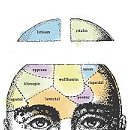In his Scientific American blog, Scott Barry Kaufman discusses a study that provides new perspectives on the controversial question of the links between “mental illness” and creative genius. Basically, writes Kaufman, when we broaden the spectrum of whom we’re looking at, it seems that everyone is partly mad and partly creative, and the two perspectives are intertwined in all of us.
“Once we leave the narrowed confines of the clinical setting and enter the larger general population, we see that mental disorders are far from categorical,” writes Kaufman. “Every single healthy human being lies somewhere on every psychopathology spectrum… What’s more, we each show substantial fluctuations on each of these dimensions each day, and across our lifespan.”
Kaufman says the authors of a new study in Frontiers in Psychology found that creativity and creative achievement were significantly associated with both psychoticism and hypomania.
“Psychoticism is characterized by impulsivity, sensation-seeking, and proneness to psychosis,” writes Kaufman. “Many of the items on the psychoticism scale measure oddness of thought and behavior, such as ‘Other people seem to think my behavior is weird’, ‘My thoughts are strange and unpredictable’, and ‘My thoughts often don’t make sense to others.’ In a clinical setting, extremely high levels of psychoticism may be cause for a diagnosis of mental illness, but this finding suggests that in the normally varying general population, there is an association between these characteristics and real-world creative achievement.”
“Creativity was also associated with hypomania,” continues Kaufman, “a mood state characterized by high energy levels, rapid mood fluctuations, and racing thoughts. Some items on the hypomania scale include ‘I am frequently in such high spirits that I can’t concentrate on any one thing for too long’, ‘I have such a wide range of interests that I often don’t know what to do next’, and ‘Sometimes ideas and insights come to me so fast that I cannot express them all’.”
Kaufman explains that “creative achievement is associated with the ability to broaden attention and have a ‘leaky’ mental filter. In other words, perhaps the very same characteristics that may hinder performance on IQ tests and standardized academic tests (e.g., broad attention, impulsivity, daydreaming, and fantasy-proneness) are the very same characteristics that increase the chances of real-life creative achievement.”
The Real Link Between the Psychopathology Spectrum and the Creativity Spectrum (Beautiful Minds, Scientific American Blogs, September 15, 2014)











